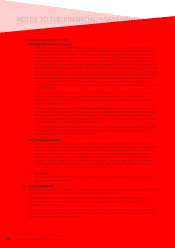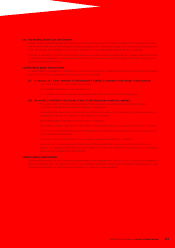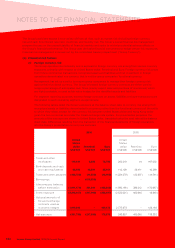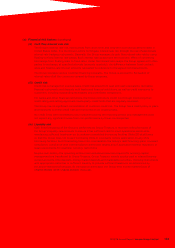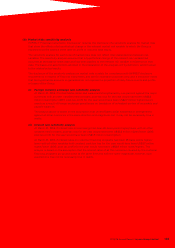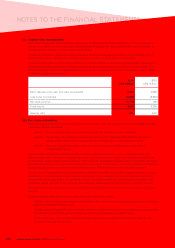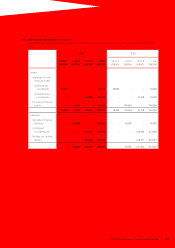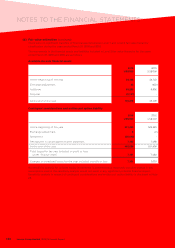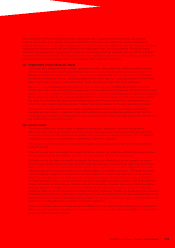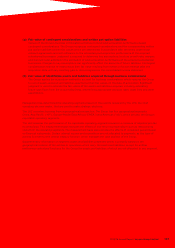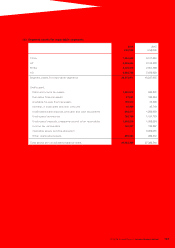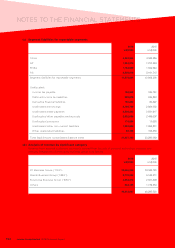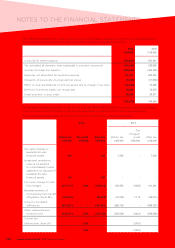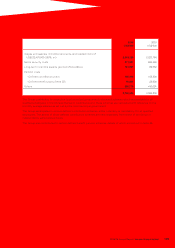Lenovo 2016 Annual Report Download - page 192
Download and view the complete annual report
Please find page 192 of the 2016 Lenovo annual report below. You can navigate through the pages in the report by either clicking on the pages listed below, or by using the keyword search tool below to find specific information within the annual report.
190 Lenovo Group Limited 2015/16 Annual Report
NOTES TO THE FINANCIAL STATEMENTS
4 CRITICAL ACCOUNTING ESTIMATES AND JUDGMENTS (continued)
(c) Warranty provision
Warranty provision is based on the estimated cost of product warranties when revenue is recognized. Factors
that affect the Group’s warranty liability include the number of sold units currently under warranty, historical
and anticipated rates of warranty claims on those units, and cost per claim to satisfy our warranty obligation.
The estimation basis is reviewed on an on-going basis and revised where appropriate. Certain of these costs
are reimbursable from the suppliers in accordance with the terms of relevant arrangements with the suppliers.
These amounts are recognized as a separate asset, to the extent of the amount of the provision made, when
it is virtually certain that reimbursement will be received if the Group settles the obligation.
(d) Revenue recognition
Application of various accounting principles related to the measurement and recognition of revenue requires
the Group to make judgments and estimates. Specifically, complex arrangements with non-standard terms
and conditions may require significant contract interpretation to determine the appropriate accounting,
including whether the deliverables specified in a multiple element arrangement should be treated as separate
units of accounting. Other significant judgments include determining whether the Group or a reseller is acting
as the principal in a transaction and whether separate contracts are considered part of one arrangement.
The Group sells products to channels. Sales through channels are primarily made under agreements allowing
for volume discounts, price protection and rebates, and marketing development funds. The Group monitors
the channel inventory level with reference to historical data. Revenue recognition is also impacted by the
Group’s ability to estimate volume discounts, price protection and rebates, marketing development funds. The
Group considers various factors, including a review of specific transactions, historical experience, market and
economic conditions and channel inventory level when calculating these provisions and allowances.
Revenue from sales of goods is recognized when both ownership and risk of loss are effectively transferred
to customer, which are generally occurred upon shipment. For certain transactions, risk of loss associated
with goods-in-transit is retained by the Group, in which the Group books revenue upon delivery of products
and defers the amounts of revenue based on the estimated days-in-transit at the end of each month. The
days-in-transit is estimated based on the Group’s weighted average estimated time of shipment arrival. Cost
of in-transit products is deferred in deposits, prepayment and other receivables in the balance sheet until
revenue is recognized. The estimates of days-in-transit are reviewed semi-annually.
(e) Retirement benefits
Pension and other post-retirement benefit costs and obligations are dependent on various assumptions. The
Group’s major assumptions primarily relate to discount rate, expected return on assets, and salary growth. In
determining the discount rate, the Group references market yields at the balance sheet date on high quality
corporate bonds. The currency and term of the bonds are consistent with the currency and estimated term of
the benefit obligations being valued. The expected return on plan assets is based on market expectations for
returns over the life of the related assets and obligations. The salary growth assumptions reflect the Group’s
long-term actual experience and future and near-term outlook. Actual results that differ from the assumptions
are generally recognized in the year they occur.
(f) Fair value of derivatives and other financial instruments
The fair value of financial instruments that are not traded in an active market (for example, over-the-counter
derivatives) is determined by using valuation techniques. The Group uses its judgment to select a variety of
methods and make assumptions that are mainly based on market conditions existing at each balance sheet
date. The Group has used discounted cash flow analyses for various available-for-sale financial assets that are
not traded in active markets.


